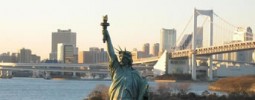Maribor is the second largest city in Slovenia, after it’s capital Ljubljana. The city is situated on the banks of the Drava river, on the meeting point with the Drava Valley, Drava Plain and the Pohorje mountain. As of latest measurement the city of Maribor has a population of 140 thousand people.
Maribor is an easy reach for travelers as it’s accessible by car, train, plane, bus and bike from most international and domestic destinations. Once you arrived in downtown Maribor it’s advisable to proceed on foot as it’s quite a small town, there are also two tourist information centers, they are located at Partizanska ulica 6a, just next to the Franciscan Church and the Old Vine House on Lent (oldest part of Maribor nearby Vojašniška ulica 8). They are opened everyday providing help in accommodation and free maps of the town. Maps of central Maribor can also be found in the town streets on the walls of houses.
The city of Maribor has a rich history and culture with many sightseeing’s including the Water tower (also known as vodni stolp), also the Mariborski grad (Maribor’s castle), Stara trta (Old Vine), Stolnica (Cathedral), Kulturni center Sinagoga (Cultural centre Synagogue) and Vinagova vinska klet (Vinag Wine Cellar) are popular among under the tourists as well local citizens. It’s advised for tourists to buy a quality bottle of wine brewed in the Maribor wine fields as it’s worldwide known as one of the best. Especially the white wine, which also can be purchased in local supermarkets.
All nationalities are required to bring a valid passport to enter Slovenia, except European Union citizens with valid national ID cards. If you are from the United States, you need to present the passport but do not need to show your return ticket or to get a visa if you are staying for up to three months only.
Ljubljana is Slovenia’s capital and largest city. Still, the city whose name is almost the same as the word meaning “beloved”, ljubljena, is a mini-wonder. Though small according to some metropolitan standards, Ljubljana delivers with a complete package of culture, modern nightlife and focus on education and the arts. Ljubljana may just as well mean “beloved” but historians are still in disagreement over its real name origin. Laburus, a long-gone Slavic city, is one of the primary suspects. Other words such as Slavic “Luba” and Latin “Aluviana” are also being considered as possible origins. Whatever the real source of its name, the city is home to 270 thousand according to the latest measurement.
If you want a relaxing holiday, Ljubljana may be the answer. It is not as big or as grand as Budapest or Prague, popular European destinations, but it offers a little bit of everything in a smaller package. Walk the city streets and you will find something that will absolutely charm you: from Old Town’s quaint coffee shops to Metelkova’s toast to alternative lifestyles. Think of the city as a small gift you will unwrap only to discover a gemstone.
You can reach Ljubljana through a final stop at Ljubljana Airport. The airport can be reached from many European cities. When you arrive on the city itself, you can travel to any other part of Slovenia because not only is it the capital but is also the center of the country’s road network. In the city, you can get around by bus or train. You can also take a taxi ride if you want to get to your destination faster. If, however, you are there for the sight-seeing, a rented bicycle may do the trick. Expect mild summers and cold winters in Ljubljana.
All nationalities are required to bring a valid passport to enter Slovenia, except European Union citizens with valid national ID cards. If you are from the United States, you need to present the passport but do not need to show your return ticket or to get a visa if you are staying for up to three months only.








